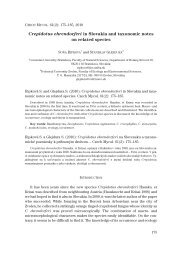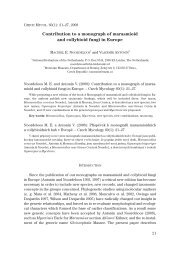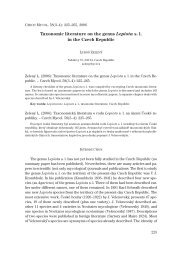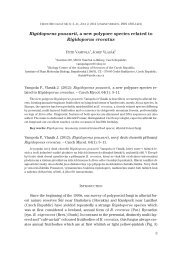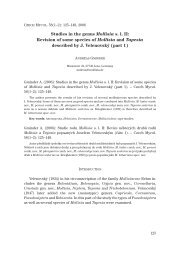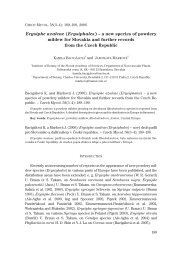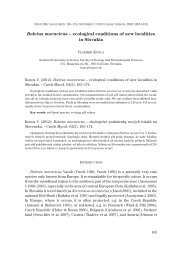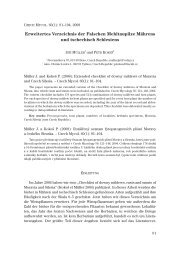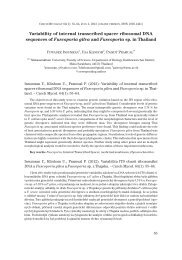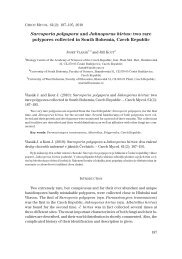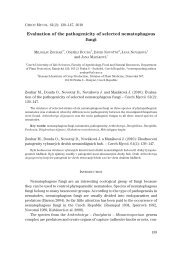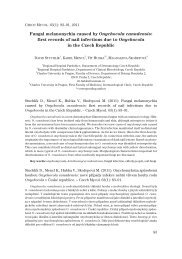Boletus kluzakii, a new species related to Boletus radicans - CZECH ...
Boletus kluzakii, a new species related to Boletus radicans - CZECH ...
Boletus kluzakii, a new species related to Boletus radicans - CZECH ...
Create successful ePaper yourself
Turn your PDF publications into a flip-book with our unique Google optimized e-Paper software.
ŠUTARA J. AND ŠPINAR P.: BOLETUS KLUZAKII, A NEW SPECIES RELATED TO BOLETUS RADICANSvel subdepressi prope stipitem, 0,7–1,3 cm longi, flavi, fracti caerulescentes, poriconcolores, minuti, rotundi, tactu fortiter caerulescentes. Stipes 6–9 × 2–3(–4)cm, cylindraceus vel cylindraceo-clavatus, reticulatus, flavus, basi interdumbrunneo maculatus. Caro pallide flavida vel flava, fracta caerulescens; stratumcarnis sub cute pilei rubrum vel purpureo-rubrum. Sapor amarus. Sporae leaves,subfusoideae, (10–)11,5–14(–16) × (4,5–)4,8–6(–6,5) μm.Affinis Boleti radicantis Pers.: Fr., sed stratum carnis sub cute pilei rubrum velpurpureo-rubrum, superficies pilei tactu conspicue rubescens et pileus mox plusminusve roseus, purpureo-roseus, qui etiam interdum partim purpureo-rubellus.H o l o t y p u s : Bohemia meridionalis, prope Sezimovo Ústí, in aggere piscinaeLuční, in graminosis sub Quercu robore, 21.IX.1997, leg. P. Špinar et al. Holotypusin herbario Musaei Nationalis Pragae (PRM 857093) et isotypus in herbariopriva<strong>to</strong> J. Šutara asservatur (JŠ 3889).P i l e u s at first hemispherical, then convex with an incurved margin, finallypulvinate, 7–15 cm in diameter, when young whitish or pallid with a slight greyish,cream-coloured or pinkish tint, then more or less rose-pink or purplish pink, attimes even purple-reddish (rarely also brownish) in some places. Pileus surfaceimmediately stains red when handled or bruised. After many hours the colour ofthe bruised places slowly changes from red <strong>to</strong> pale brownish or (when the pileussurface was bruised more strongly) <strong>to</strong> deep brown. Pileus cuticle sub<strong>to</strong>men<strong>to</strong>se,gradually glabrescent, dry, matt but somewhat tacky (subviscid) when moist.Subcuticular layer of context red or purplish red. A hint of the reddish tinge of thesubcuticular layer persists even in some dried specimens. Other parts of thepileus context pale yellowish or, above tubes, vivid yellow, when cut turning blue.Taste bitter, smell of mushrooms but not very distinct.Tu b e s almost adnate or somewhat depressed around the stipe, 0.7–1.3 cmlong, lemon-yellow, becoming olive-yellow or brownish yellow with age, bluingwhen cut. Pores small, roundish, concolorous with tube-sides, when bruisedstrongly bluing and then (after several hours) very slowly becoming brown.S t i p e 6–9 cm long, 2–3(–4) cm thick, cylindrical or somewhat broadeneddownwards, vivid yellow above, light yellow below, sometimes with rusty brownspots on base, reticulate nearly over the entire length or at least in upper part, reticulationyellow, darkening on handling. Context vivid yellow at apex, pale yellowishin middle part, ochraceous or light brownish and sometimes also partlywine-red in basal area, when cut changing <strong>to</strong> blue, particularly in apex. Basal<strong>to</strong>mentum yellowish or yellow-ochraceous. Partial veil and annulus absent.P i l e u s c u t i c l e a trichoderm, when young 400–600(–800) μm thick, composedof filamen<strong>to</strong>us, erect or suberect hyphae, gradually collapsing in later developmentalstages, finally forming a collapsed, only 50–100(–150) μm thick layerof hyphae more or less appressed <strong>to</strong> the pileus surface. In this collapsed state the33
<strong>CZECH</strong> MYCOL. 58(1–2): 31–42, 2006trichoderm sometimes looks like a cutis. Trichodermal hyphae (3–)4–7(–10) μmwide, consisting of long elements, in pure water colourless or (on some parts ofpileus of older carpophores) pale brownish. Surface of the trichodermal hyphaesmooth or covered with a gelatinous matter distinct in microscopic preparationsstained with Congo-Red (in Melzer’s reagent looking as if covered with an incrustation).Subcuticular layer of tissue reddish pink when mounted in pure water(but this reddish pigmentation disappears in Melzer’s reagent or ammonium solution).Thickness of the reddish subcuticular layer (measured in revived herbariummaterial) 250–500(–700) μm. Pileus trama composed of loosely interwoven, filamen<strong>to</strong>usor somewhat broadened hyphae, (3–)5–14(–18) μm wide, non-amyloid,light-coloured <strong>to</strong> honey-brownish in Melzer’s reagent.Hymenophoral trama true bole<strong>to</strong>id. Lateral strata divergent, more orless gelatinous, very light-coloured when mounted in Congo-Red, in a fully developedstage (30–)40–50(–60) μm thick, loosely arranged, with hyphae 3–14 μmwide, not <strong>to</strong>uching each other. Distance between hyphae of the lateral stratum intransverse sections (2–)4–8(–12) μm. Mediostratum (8–)12–20(–30) μm, readilystaining with Congo-Red, densely arranged, with hyphae <strong>to</strong>uching one another.Subhymenium 7–10(–15) μm. Hymenium 24–30(–34) μm. Basidia clavate, mostly4-spored, 22–38(–42) × 8–13 μm, usually with a granular and partly globular content.Cheilocystidia smooth– and thin-walled, fusiform or subclavate with somewhatpointed <strong>to</strong>ps, 25–36 × 6–11 μm. Pleurocystidia very sparsely scattered, inconspicuous,smooth– and thin-walled, fusiform or fusiform-rostrate, rarelylageniform, 30–46 × 8–13 μm.Spores ofbole<strong>to</strong>idshape,infaceviewfusoid-ellipsoid, in profile inequilateralwith suprahilar depression, smooth under a light microscope, (10–)11.5–14(–16) ×(4.5–)4.8–6(–6.5) μm, Q (length-breadth ratio) = (1.7–)2.2–2.7(–3.0), yellow orbrownish in Melzer’s reagent. Spore print not obtained (probably brownish with anolivaceous tint as in other boletes of <strong>Boletus</strong> L. section Calopodes Fr.).S t i p e s u r f a c e fertile, covered by a gradually fragmenting caulohymeniumwith scattered sporulating caulobasidia. Caulohymenium 25–32(–35) μm.Caulobasidia 24–40 × 8–13 μm, clavate, mostly 4-spored, often with a granular andpartly globular content. Caulocystidia fusiform or fusiform-rostrate, 30–50 × 7–12μm. Lateral stipe stratum of bole<strong>to</strong>id type, well-developed in upper and middlepart of stipe, loosely arranged, with a tendency <strong>to</strong> gelatinise, (30–)40–90 μm thick,in ridges of the stipe reticulation up <strong>to</strong> 170 μm (for the meaning of the term ‘lateralstipe stratum’, see Šutara 2005). Stipe base infertile, covered with a <strong>to</strong>mentumloosely entangled of filamen<strong>to</strong>us, 3–6(–8) μm wide hyphae. Stipe trama composedof 3–16 μm broad hyphae, densely and more or less regularly arranged, parallelwith longitudinal stipe axis, non-amyloid, almost hyaline or pale yellow-brownishin Melzer’s reagent. Trama of both pileus and stipe composed of a monomitic34
ŠUTARA J. AND ŠPINAR P.: BOLETUS KLUZAKII, A NEW SPECIES RELATED TO BOLETUS RADICANSFig. 1. <strong>Boletus</strong> <strong>kluzakii</strong> (PRM 857093, holotype). – a: Trichodermal hyphae of the pileus cuticle. – b:Trichodermal hyphae covered with a gelatinous matter in detail. – c: Pleurocystidia. – d: Spores. – e:Caulobasidia. – f: Cheilocystidia. – g: Caulocystidia.35
<strong>CZECH</strong> MYCOL. 58(1–2): 31–42, 2006hyphal system with generative, thin-walled hyphae. Clamp connections not foundin the carpophore.Solitary on soil under Quercus robur (sometimes also with Pinus sylvestris inthe vicinity), on dam of fish-pond Luční (national nature monument), not far fromSezimovo Ústí, southern Bohemia, alt. 420 m, leg. P. Špinar et al., 3 Sept., 16 Sept.and 20 Sept. 1992; 9 Sept. 1994; 16 Sept. 1996; 21 Sept. 1997 (PRM 857093,holotype; JŠ 3889, isotype); 18 July, 15 Sept. and 17 Sept. 2000 (JŠ 4215; PŠ 234).Tab. 1. Numbers of carpophores of B. <strong>kluzakii</strong> found at the locality NNM Luční.June July August September Oc<strong>to</strong>ber1992 – – – 4 –1993 – – – – –1994 – – – 1 –1995 – – – – –1996 – – – 1 –1997 – – – 1 –1998 – – – – –1999 – – – – –2000 – 1 – 2 –In 2001–2005 B. <strong>kluzakii</strong> was not found.DISCUSSION<strong>Boletus</strong> <strong>kluzakii</strong> belongs <strong>to</strong> <strong>Boletus</strong> sect. Calopodes. The most typical charactersof this <strong>species</strong> are: pileus when young whitish or pallid, sometimes witha slight pinkish tint, then more or less rose-pink or purplish pink, at times evenpurple-reddish in some places; pileus surface conspicuously reddening when handledor bruised; hymenophore (both pores and tube-sides) yellow, bluing whenbruised; stipe yellow with a yellow reticulation; context under pileus cuticle redor purplish red but in other parts of the pileus and in upper half of the stipe paleyellowish or vivid yellow, turning blue when injured; taste bitter.<strong>Boletus</strong> <strong>kluzakii</strong> is closely <strong>related</strong> <strong>to</strong> <strong>Boletus</strong> <strong>radicans</strong>, from which it differsmainly in the red or purplish red subcuticular layer of the pileus. The red colorationof this layer is easily visible both in cross-sections and in scalped places onthe pileus surface. The arrangement of the cortical zone of the pileus in two differentlycoloured layers, viz. the upper, pallid cuticle and the lower, red or purplishred subcuticular layer, is the reason why the pileus surface of <strong>Boletus</strong> <strong>kluzakii</strong>changes <strong>to</strong> red on handling or bruising. This colour change, which is usually veryconspicuous, can hardly be overlooked during collecting of carpophores. The36
<strong>CZECH</strong> MYCOL. 58(1–2): 31–42, 2006Fig. 3. <strong>Boletus</strong> <strong>kluzakii</strong>. Southern Bohemia, NNM Luční, leg. P. Špinar, 17 Sept. 2000 (JŠ 4215). Maturecarpophore with a typical, rose-pink <strong>to</strong> purplish pink coloration of the pileus.Fig. 4. <strong>Boletus</strong> <strong>kluzakii</strong>. Southern Bohemia, NNM Luční, leg. P. Špinar, 15 Sept. 2000 (PŠ 234). Pileus ofa younger carpophore. On one place of the pallid pileus surface there is a deep red spot which stainedred on bruising. Another place, which was injured more strongly, shows blue oxidation of the context.The red colour of the subcuticular layer of the pileus is distinct in several places where the upper, pallidcuticle was removed from the pileus surface by means of a scalp. Pho<strong>to</strong>graphs 3 and 4 by P. Špinar.38
ŠUTARA J. AND ŠPINAR P.: BOLETUS KLUZAKII, A NEW SPECIES RELATED TO BOLETUS RADICANSpresence of the red subcuticular layer and the reddening of the pileus surface arecharacters important particularly for the identification of younger carpophores ofB. <strong>kluzakii</strong>, which have a whitish or pallid pileus and are, at first sight, rather similar<strong>to</strong> those of B. <strong>radicans</strong>. InB. <strong>radicans</strong> the layer under the pileus cuticle ispale brownish or grey-brownish (not red) and the pileus surface stains brown orgrey-brown when bruised, and blue-brown or blue when more strongly injured.In later developmental stages, B. <strong>kluzakii</strong> is also usually different fromB. <strong>radicans</strong> in the rose-pink or purplish pink pileus, which is sometimes evenpartly purple-reddish. Typical forms of B. <strong>radicans</strong> have the pileus whitish, whitegreyish,pale cream-coloured or pale beige, at times (particularly in oldercarpophores) pale brownish in some places. A form of B. <strong>radicans</strong> with a partlyreddish pileus exists, but is very rare. From the <strong>to</strong>tal number of more than 2 thousandcarpophores of B. <strong>radicans</strong> examined at 16 localities in the Czech Republic,the authors of this contribution found this partly reddish form only nine times,only at 3 localities. Results of the observations of the present authors can be summarisedas follows.In the partly reddish form of B. <strong>radicans</strong>, the reddish shade on the pileus occursonly in the superficial layer of the cuticle. The lower, subcuticular layer of thepileus is constantly pale brownish or grey-brownish and also the pileus surfacestains brown when bruised as in the other forms of B. <strong>radicans</strong>. Moreover, in thereddish form of B. <strong>radicans</strong> the reddish shade is developed relatively soon (alreadyin young carpophores) and only on a smaller part, mostly on the marginalzone of one side of the pileus. In maturing carpophores this reddish shade completelyfades away.In B. <strong>kluzakii</strong>, the reddish coloration develops in another way. The pileus is atfirst whitish, pallid or only very slightly pinkish, because in young carpophores ofB. <strong>kluzakii</strong> the lower, purplish red subcuticular layer is covered by the upper,whitish sub<strong>to</strong>men<strong>to</strong>se cuticle which is, in this young stage, composed of a well-developed,400–800 μm thick trichodermal layer of erect or suberect hyphae. Duringfurther stages the trichoderm gradually collapses or is partly washed away andslowly exposes the red subcuticular layer, which gradually gives a more and moredistinct rose-pink or purplish pink <strong>to</strong>ne <strong>to</strong> the whole pileus.The results of the present authors’ observations on B. <strong>radicans</strong> agree roughlywith descriptions of this <strong>species</strong> published in the mycological literature. <strong>Boletus</strong><strong>radicans</strong> (= <strong>Boletus</strong> albidus) is generally considered a <strong>species</strong> whose pileus iswhitish or pallid, with various pale greyish, pale cream-coloured, pale ochraceousor pale brownish shades (see Alessio 1985, Muñoz 2005, Watling and Hills 2005,and many others). Persoon (1801: 507) described the colour of the pileus in hisoriginal diagnosis of <strong>Boletus</strong> <strong>radicans</strong> in the following way: ‘pileo … flavescentecinereo’.Nevertheless, some authors (e.g. Kallenbach 1926-1942, Pilát andDermek 1974) noticed that the pileus of this <strong>species</strong> may also be somewhat red-39
<strong>CZECH</strong> MYCOL. 58(1–2): 31–42, 2006dish in rare cases. These authors, however, never mentioned the red colour of thesubcuticular layer and the conspicuous reddening of the pileus surface on bruising,which are the most typical characters of <strong>Boletus</strong> <strong>kluzakii</strong>. In his descriptionof B. <strong>radicans</strong>, Kallenbach (1926-1942: 90) wrote: ‘Hut … beim Liegen und beiDruck etwas dunkler bräunlichgrau, zuweilen bei Druck etwas blauend; ... Fleisch... unter Huthaut etwas graulich bis bräunlich’. According <strong>to</strong> Pilát and Dermek(1974: 104-105), the characters of the pileus of B. <strong>radicans</strong> are as follows: ‘Cuticle… stains bluish grey or blue where bruised … Context … under the pileus cuticlewith a greyish or delicate blue tint’ (translation from Slovak by Šutara).In the state when the pileus of B. <strong>kluzakii</strong> is rose-pink, purplish pink or evenpartly purple-reddish (i.e. on handling or in later stages of development), thecarpophores of this <strong>species</strong> resemble those of <strong>Boletus</strong> regius Krombh. Distinguishingthese two <strong>species</strong>, however, is not difficult because <strong>Boletus</strong> regius hasboth its hymenophore and context unchanging (not bluing) and the taste of itscontext is mild and pleasant (not bitter).<strong>Boletus</strong> roseoolivaceus Blum, which has a brownish, chamois, beige-greenishpileus with a carmine shade and a bitter context, differs from B. <strong>kluzakii</strong> in thedominant red colour of the stipe (like <strong>Boletus</strong> calopus Pers.: Fr.), positive amyloidreaction of the context and somewhat broader spores (6–7 μm) (see Blum 1970).Also <strong>Boletus</strong> pulchrotinctus Alessio and <strong>Boletus</strong> fuscoroseus (= <strong>Boletus</strong>pseudoregius) have pink or reddish shades of the pileus. These <strong>species</strong>, however,have not a bitter context and their stipes are distinctly pink or reddish in the middleor lower part (see Alessio 1985, Estades 1988). <strong>Boletus</strong> pulchrotinctus moreoverdiffers in much larger spores (12–18 × 6–8.5 μm).<strong>Boletus</strong> speciosus Frost, which was formerly incorrectly connected withB. fuscoroseus (or B. pseudoregius), differs from B. <strong>kluzakii</strong> in the mild taste ofits context, darker pileus, and red coloration of the lower part of stipe (see Cokerand Beers 1943, Smith and Thiers 1971, Both 1993, Bessette et al. 2000, and others).North American material of <strong>Boletus</strong> speciosus examined by the first authorwas also different from B. <strong>kluzakii</strong> in some microscopic characters, especially inits distinctly narrower spores (3–4.5 μm) and in a large number of conspicuouslyinflate, subglobose cells in the caulohymenium.<strong>Boletus</strong> roseopurpureus Both, A. E. Bessette et Roody, a North American <strong>species</strong>,has a striking pinkish purple <strong>to</strong> dark purplish red pileus (not whitish inyouth), taste of context very sour like lemon (not bitter), very narrow spores(2.7–3.5 μm) and a white basal part of stipe (see Bessette et al. 2000).Another North American <strong>species</strong>, <strong>Boletus</strong> pulchriceps Both, A. E. Bessette etChapman, has also a pinkish pileus in a certain developmental stage, but itshymenophore and context are unchanging or only very weakly bluing, its taste isnot bitter, and its <strong>to</strong>mentum on the stipe base is white (see Bessette et al. 2000).40
ŠUTARA J. AND ŠPINAR P.: BOLETUS KLUZAKII, A NEW SPECIES RELATED TO BOLETUS RADICANSIn our opinion, B. <strong>kluzakii</strong> is identical with <strong>Boletus</strong> fallax Kluzák, which wasfound in 1981 under Quercus robur and Tilia cordata on a dam of fish-pondNaděje near Hrbov, east of Prachatice in southern Bohemia (Kluzák 1988). Unfortunately,<strong>Boletus</strong> fallax Kluzák cannot be considered a correct name because it isa later homonym of <strong>Boletus</strong> fallax Corner. Corner’s <strong>Boletus</strong> fallax is a Malaysian<strong>species</strong>, which is very different from Kluzák’s bolete in many characters, above allin longitudinally striate spores (see Corner 1972). <strong>Boletus</strong> fallax Corner was latertransferred by Watling (1990) <strong>to</strong> the genus Boletellus Murrill.M a t e r i a l e x a m i n e d : – Typical forms of <strong>Boletus</strong> <strong>radicans</strong> without any reddishshade on pileus: JŠ 2120, 2534, 2785, 3143-45, 3876, 3880-86, 4035-37, 4216-33,4254-56, 4261; PŠ 9, 10, 18-21, 29, 41, 48, 49, 53, 58-61, 68, 206, 208, 300, 321-22, 623,638, 670, 1001 etc. – Specimens of <strong>Boletus</strong> <strong>radicans</strong> with a reddish shade on a par<strong>to</strong>f the pileus: JŠ 3661-62; PŠ 113, 115, 118, 181-185, 195. – <strong>Boletus</strong> regius: PRM614841, 866632; JŠ 044, 3525; PŠ 2000. – <strong>Boletus</strong> fuscoroseus: JŠ 4244; PŠ 86, 89,95, and CB 1352, 1782 (misidentified as <strong>Boletus</strong> speciosus). – <strong>Boletus</strong> speciosus:PRM 704843, 704844 (material from U.S.A., collected and identified by E. Both). –<strong>Boletus</strong> fallax Kluzák: CB 5001 (holotype).ACKNOWLEDGEMENTSWe wish <strong>to</strong> thank <strong>to</strong> Prom. Biol. Zdeněk Pouzar, CSc., and Dr. Jan Holec, theNational Museum, Prague (PRM), for revising the manuscript. We also thankEdvard Skála for his colour pho<strong>to</strong>graph of <strong>Boletus</strong> <strong>kluzakii</strong> and Vladimír Zíta forhis technical help with preparing illustrations for this paper. We are grateful <strong>to</strong> thelate Prof. Zdeněk Kluzák, former cura<strong>to</strong>r of the herbarium of the South BohemianMuseum, České Budějovice (CB), for lending herbarium material.REFERENCESALESSIO C. L. (1985): <strong>Boletus</strong> Dill. ex L. (sensu la<strong>to</strong>). – In: Fungi Europaei 2, 712 p., 84 pl., Saronno.BERAN M. and ŠPINAR P. (1996): Mykoflóra hráze rybníka Luční na Táborsku. – Sbor. Jihočes. Muz.v Čes. Budějovicích, Přírod. Vědy 36: 35–58.BESSETTE A. E., ROODY W. C. and BESSETTE A. R. (2000): North American boletes. – 396 p., 80 pl., NewYork.BLUM (1970): Revision des bolets. – Bull. Soc. Mycol. France 86(1): 215–256.BOTH E. E. (1993): The Boletes of North America. A compendium. – 431 p. Buffalo.COKER W.C. and BEERS A.H. (1943): The Boleti of North Carolina (an unabridged republication, 1974). –96 p., 65 pl., New York.CORNER E. J. H. (1972): <strong>Boletus</strong> in Malaysia. – 263 p. Singapore.ESTADES A. (1988): <strong>Boletus</strong> pseudoregius (Huber) comb. nov. – Bull. Féd. Mycol. Dauphiné-Savoie no.108: 6–8.41



